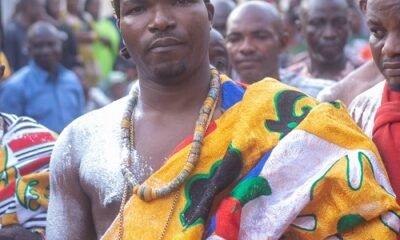Fruitful Living
Qur’an: A Book of Guidance beyond Ramadan (Pt.2)
The Structure of the Qur’an
The Qur’an consists of 114 chapters (Surahs), classified into Makkan and Madinan chapters:
•86 Makkan Surahs – Revealed in Makkah before migration, primarily focusing on faith, monotheism, and the Hereafter.
•28 Madinan Surahs – Revealed in Madinah, covering laws, governance, and societal justice.
Each chapter contains divine instructions, addressing spiritual, moral, and legal matters.
The Qur’an itself testifies about its revelation:
“The month of Ramadan in which was revealed the Qur’an, a guidance for the people and clear proofs of guidance and criterion…” (Qur’an 2:185).
The first revelation occurred in the Cave of Hira, where Prophet Muhammad was commanded:
“Read in the name of your Lord who created—Created man from a clinging substance. Read, and your Lord is the Most Generous—Who taught by the pen—taught man that which he knew not” (Qur’an 96:1-5).
This event marked the beginning of divine communication between Allah and His final messenger.
The Quran as a book of Justice and Morality
“Indeed, Allah commands you to act with justice, to do good, and to give to relatives, and He forbids immorality, bad conduct, and oppression. He admonishes you so that you may take heed.” (Qur’an 16:90)
This text is often recited in Friday sermons (Khutbah) as a reminder to believers about the core values of Islam: justice, kindness, family ties, and avoidance of immorality and wrongdoing. It serves as a comprehensive command for ethical and moral behavior in both personal and societal affairs.
The Quran Commands Modesty in Dress code
“O Prophet, tell your wives and your daughters and the women of the believers to bring down over themselves [part] of their outer garments. That is more suitable that they will be known and not be abused. And ever is Allah Forgiving and Merciful.” (Qur’an 33:59)
Explanation of the Verse:
This verse was revealed as a directive for Muslim women to wear the jilbab—a long, loose-fitting outer garment— that covers their bodies when they go out in public.
Allah commands the Prophet to instruct his wives, daughters, and all believing women to adopt a modest dress code to bring down over themselves [part] of their outer garments) instructs Muslim women to cover themselves in a way that distinguishes them as modest and chaste women.
That is more suitable that they will be known and not be abused. This means that modest dress helps identify believing women as respectable and pious, preventing harassment or harm from ill-intentioned people.
Allah’s Mercy in the Command
The verse ends with (And ever is Allah Forgiving and Merciful), showing that Allah’s commands are for the protection and honor of women, and those who struggle with observing them can seek His forgiveness and guidance.
The Qur’an as a Guide for All of Humanity
The Qur’an is not restricted to any race, nationality, or social class. It is a universal book meant to guide all of humanity—men and women, the rich and the poor, Arabs and non-Arabs. Allah says:
“And We have certainly made the Qur’an easy for remembrance, so is there any who will remember?” (Qur’an 54:17).
“And We have not sent you, [O Muhammad], except as a mercy to the worlds.” (Qur’an 21:107).
This means that no one is excluded from the mercy of the Qur’an. It is a guide for the lost, a source of hope for the despairing, and a moral code for all societies.
* The writer is the Metropolitan Chief Imam of Kpone Katamanso
By Imam Alhaji Saeed Abdulai – 1 BN Michel Camp, Tema
Fruitful Living
Has man lost the essence of his creation? A reflective call to rediscover our divine purpose (Part 1)
Introduction: Rediscoveringour purpose
Praise be to Allah, the Lord of the Worlds. We praise Him, seek His help and forgiveness, and ask for His mercy. May the peace and blessings of Allah be upon our noble Prophet Muhammad (peace be upon him), his family, his companions, and all those who follow his guidance until the Day of Judgment.
In today’s increasingly materialistic and turbulent world, a profound question echoes louder than ever: Has man lost the essence of his creation? It is a question that compels every thinking soul to pause and reflect deeply.
In the midst of scientific breakthroughs, booming technology, and economic pursuits, we must ask ourselves: are we fulfilling the sacred purpose for which we were created? Are we still living as stewards of Allah on earth, or have we strayed from our divine assignment?
This article explores the Qur’anic foundation of man’s creation, the noble position he holds, and the deviation from this divine path in modern times. It further calls for a return to spiritual consciousness and outlines practical steps to help realign mankind with his intended purpose.
Man: Allah’s Vicegerent on Earth
The Qur’an states: “And when your Lord said to the angels, ‘Indeed, I will make upon the earth a vicegerent (Khalifah)…’” (Surah Al-Baqarah, 2:30).
This declaration marks the beginning of man’s honorable journey on earth. Mankind was created from clay, as recorded in Surah Al-Hijr:
“And We did certainly create man out of clay from an altered black mud. And the jinn We created before from scorching fire. And [mention] when your Lord said to the angels, ‘I will create a human being out of clay from an altered black mud.’ So when I have proportioned him and breathed into him of My [created] soul, then fall down to him in prostration.” (Surah Al-Hijr, 15:26-29).
This prostration of angels was not to worship Adam, but to recognize the honor Allah had bestowed upon man. It signified a spiritual hierarchy in which man, though of earthly origin, carries a divine trust and responsibility.
Prophet Muhammad (peace be upon him) emphasized this dignity. He taught that every human is born upon the natural disposition (fitrah) and bears the potential to fulfill their purpose as a servant of Allah and custodian of His creation.
The Purpose of Creation
Allah did not create man in vain. The Qur’an states clearly: “And I did not create the jinn and mankind except to worship Me.” (Surah Adh-Dhariyat, 51:56).
“And they were not commanded except to worship Allah, [being] sincere to Him in religion, inclining to truth, and to establish prayer and to give zakah. And that is the correct religion.” (Surah Al-Bayyinah, 98:5).
Another profound verse underscores that life was not created aimlessly:
“And We did not create the heaven and the earth and that between them aimlessly. That is the assumption of those who disbelieve, so woe to those who disbelieve from the Fire.”(Surah Sad, 38:27).
These verses convey that creation is intentional, meaningful, and divinely ordained. The essence of man’s creation lies in his recognition of Allah, his conscious submission to the Divine Will, and his dedication to a life of worship, service, and ethical living.
Worship in Islam is not confined to rituals alone but extends to every aspect of human existence—how we earn, govern, lead our families, engage with society, and preserve the environment. Every righteous deed done with sincerity for Allah’s pleasure becomes an act of worship.
Imam Al-Ghazali explains in Ihya Ulum al-Din that true worship stems from knowledge of Allah and a heart that submits lovingly to His will. Ibn Qayyim al-Jawziyyah likewise stresses that man’s highest honor lies in fulfilling the purpose of servitude (`ubudiyyah) to Allah, which brings inner peace and divine elevation.
Prophet Muhammad (peace be upon him) demonstrated this perfect balance of worship and engagement in worldly affairs. He was a husband, a leader, a statesman, and a worshipper who said: “The most beloved deeds to Allah are the most consistent, even if they are few.”
(Sahih al-Bukhari, Hadith 6464)
Living in harmony with this divine purpose not only brings personal fulfillment but also collective peace. Conversely, neglecting it results in moral confusion, injustice, and spiritual emptiness.
Therefore, recognizing and living by our purpose is not a luxury but a necessity. It is the key to real success in this life and salvation in the Hereafter.
By Imam Alhaji Saeed Abdulai, the Author
Fruitful Living
Trusting God with our anxieties (final)

Jesus not only instructs us not to worry — He explains why worrying is counterproductive to our well-being:
❖ Worry is blind. It refuses to learn from nature, history, or personal experience. Birds and flowers testify to God’s faithfulness. The history of Israel is filled with God’s miraculous provision — from Egypt to the Red Sea to the Promised Land (Deut. 8:14–15).
❖ Worry refuses to learn the lesson of life. Time and again, God has helped us bear the unbearable and overcome the insurmountable. He strengthens us even when we reach the breaking point — and keeps us from breaking.
❖ Worry is irreligious. It stems not from our external circumstances, but from a heart full of fear and distrust. Yet Scripture declares:“You will keep in perfect peace him whose mind is steadfast, because he trusts in you.” — Isaiah 26:3 (NIV)
The antidote to worry: El shaddai
Proverbs 18:10 says, “The name of the Lord is a strong tower; the righteous run to it and are safe.” One of the most comforting names of God is El Shaddai, which first appears in Genesis 17:1 and appears 218 times in the Bible.
❖ El means “Strong One.”
❖ Shaddai means “The Breasted One.”
Together, El Shaddai paints a picture of God as:
❖ Our Strong Nourisher
❖ Strength Giver
❖ Satisfier
❖ All-Bountiful Supplier
❖ Fulfiller of Needs
❖ The Life-Giver who brings dead things back to life
(e.g., Abraham and Sarah conceiving Isaac at 150 and 90 years respectively)
In knowing who God is, we find the courage to release our anxieties. If He is truly El Shaddai — strong, sufficient, and sustaining — then we are safe in His hands.
Practical steps to peace
In Philippians 4:6–7, we are given a divine prescription for peace:
1. Stop being anxious and fretful. Recognize the emotional and spiritual toll of worry.
2. Go to God in prayer about everything. Nothing is too big or small.
3. Pray for yourself. God is your Father — your relationship with Him is personal.
4. Thank Him as you pray. Gratitude builds faith and reminds us of His past faithfulness.
When we do this, God’s peace — not the world’s peace — will guard our hearts and minds in Christ Jesus.
“And the peace of God, which transcends all understanding, will guard your hearts and your minds in Christ Jesus.” — Philippians 4:7 (NIV)
CONCLUSION
We are living in uncertain times. Pressures abound and anxieties easily multiply. But as children of God, we are called to walk a different path — one of quiet confidence, steady trust, and daily surrender.
God’s Word is clear: worry doesn’t help — but trust in God brings peace. Let us shift our focus from fear to faith, from anxiety to adoration. Let us anchor our hearts in the unchanging character of El Shaddai — our Almighty God — and rest in His perfect care.
By Rev. Dr Joyce Aryee, the author






